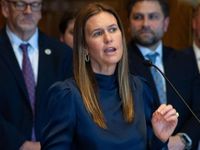In a year already marked by economic uncertainty and political wrangling, Americans are bracing for a seismic shift in health insurance costs and coverage. The aftershocks are being felt from the rural hospitals of Maine to the health insurance marketplaces of Arkansas, as policy changes at the federal level ripple out into local communities and family budgets. Recent announcements and internal documents reveal a landscape where climbing premiums, shrinking subsidies, and Medicaid cuts are converging to threaten the stability of health care access for millions.
On September 20, 2025, Arkansas Governor Sarah Sanders took to the podium to declare a partial victory for consumers. She announced that her administration had “secured average rate increases that are 35.8% lower than previously proposed” by BlueCross and Centene, the state’s two major insurance providers on the Arkansas Health Insurance Marketplace. Sanders, who had previously lambasted the insurers for suggesting “insane” 2026 rate hikes averaging 36%, framed this as evidence that political pressure could yield tangible benefits for Arkansans. “More work remains, but this is a good starting point and shows that when we stand up to insurance companies, we can win tangible benefits for the people of our state,” she said, according to the Arkansas Times.
Yet, as the governor’s own chart made clear, the average premium is still set to rise by more than 22% in 2026—a staggering jump compared to the 2% to 6% annual increases seen since 2020. For Arkansas families, this means a much larger portion of their paycheck will go toward health insurance, and many may be forced to make painful decisions about their coverage. The Arkansas Center for Health Improvement corroborated that this spike is unprecedented in recent years.
The root cause of these increases, as detailed by both state officials and independent analysts, is not simply insurer greed or local mismanagement. Instead, blame falls squarely on federal policy changes—specifically, the expiration of enhanced Affordable Care Act (ACA) subsidies. These subsidies, expanded under the Biden administration during the pandemic, fueled a surge in marketplace enrollment, more than doubling the number of Arkansans with coverage. But with Congressional Republicans refusing to renew the enhanced aid and instead slashing healthcare spending in the "One Big, Beautiful Bill," millions across the nation are now at risk of losing affordable coverage.
Internal documents from the Arkansas Insurance Department, obtained through a Freedom of Information Act request by the Arkansas Times, reveal the extent of the anticipated fallout. Officials have been bracing for the consequences of subsidy cuts for months. A memo from August projected that more than half of the roughly 166,000 Arkansans currently buying individual plans on the marketplace could drop coverage in 2026. That would leave about 80,000 people—back to pre-pandemic levels—struggling to afford insurance or going without altogether.
The mechanics of the crisis are complex but all too familiar in health policy circles. Without the enhanced federal subsidies, younger and healthier consumers are expected to drop their coverage first, leaving a risk pool dominated by older and sicker individuals. This, in turn, drives up costs for insurers, who respond by raising rates even further. As Jimmy Harris, now interim insurance commissioner, explained in an email to Arkansas’s Secretary of Commerce, “Many of the middle income families that fit in that income level will drop their insurance because they had low or no premium health insurance for their family and costs will increase substantially. Most insureds in this group have far better morbidity than what is left in the individual market, driving up premiums for the rest of the market.”
Rate increases are also being fueled by broader trends: expensive new drugs, rising labor costs, an aging population, and new mandates from the Arkansas Legislature requiring coverage of additional procedures and services. In a July email, Centene executive Brett Thompson-May warned state officials that “market morbidity trends— the rate at which people get sick or injured—were far higher than expected,” and that the numbers were so dire Centene no longer believed its rate submission for 2026 was actuarially sound.
Meanwhile, in Maine, the situation is equally fraught. Paul Bolin, executive vice president of Northern Light Health, told WABI-TV that Medicaid cuts included in the same federal legislation are forcing difficult choices. “If costs increase, we inevitably will have to reduce something,” Bolin said. “We don’t yet know exactly how much that impact will be. And that’s really, right now, what the uncertainty is with, with this legislation.”
The Congressional Budget Office estimates that 10 million people across the country will lose their health insurance over the next decade, primarily due to Medicaid cuts. While the recent GOP tax and spending plan did include a rural hospital relief fund, Bolin noted, “We don’t know how much of that would impact care here in Maine or for Northern Light. We can’t yet do the math because we don’t have all the information, but any change to the negative certainly adds to the stress to the organization.”
Northern Light Health has already closed Inland Hospital in Waterville and continues to face financial headwinds, with costs exceeding revenue. Bolin explained, “Right now our costs exceed our revenue, and so we’ve lost money. That will only become a harder equation to balance as the expense side increases with fewer people with government insurance.” The health system is now considering changes to reduce spending, such as re-evaluating its service structure and administrative staff, while striving to keep cost-saving measures as far from patient care as possible. “Our focus really is to make these changes mostly to the back-office side of things, as far away from the patient as possible, so as an organization we run more efficiently,” Bolin said.
These local struggles are playing out against a backdrop of national uncertainty. As insurers, regulators, and hospital administrators scramble to adapt, the human toll is growing. Internal records from Arkansas regulators show that even creative policy maneuvers—like “silver loading,” a strategy to maximize the remaining ACA subsidies and control out-of-pocket costs—are unlikely to fully cushion the blow. “This looks dire,” Donna Lambert, a compliance officer at the Arkansas Insurance Department, wrote in July after reviewing actuarial reports.
To make matters more confusing for consumers, the numbers released by Governor Sanders’ office ahead of the final rate approvals at the end of September showed significant discrepancies from earlier public figures, with five out of six carrier numbers differing—sometimes by nearly 30 percentage points. The governor’s office has not clarified how these figures were calculated, leaving many Arkansans uncertain about what to expect when open enrollment begins.
In the end, the only certainty is that health insurance is about to become much more expensive and less accessible for millions of Americans. As policymakers debate the next steps and families weigh their options, the stakes could hardly be higher. Whether in the rolling hills of Maine or the heartland of Arkansas, the choices made in Washington are reshaping the most basic of American promises: access to affordable health care.




